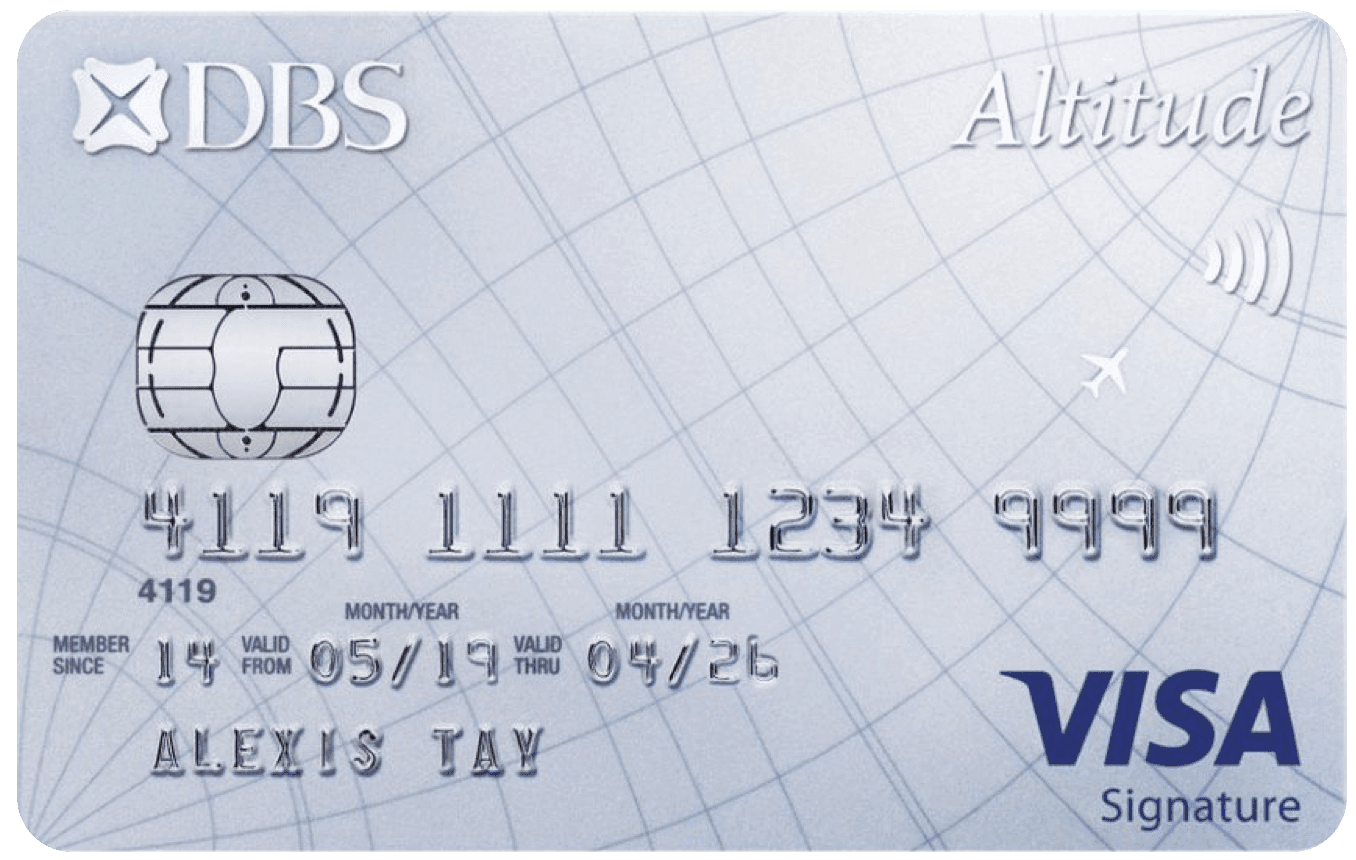
DBS Altitude Visa Signature Card
Highlights


- Welcome Offer promotion is valid until 1 February 2026.
- Promotion is valid for new DBS credit cardmembers only.
- Apply and get approved for the DBS Altitude Credit Card with a promo code, then make a min. spend of S$800 within 60 days of card approval to be eligible for miles reward.
- Apply with promo code ALTP38 and pay the annual fee (S$196.20 incl. GST) to be eligible for 38,000 miles
- Apply with promo code ALTPW28 and annual fee waiver to be eligible for 28,000 miles
- Terms and Conditions apply.
Things to consider when choosing this card:
Things to consider
Bonus air miles
Airport lounge
No expiry air miles
Unlimited air miles
Benefits
Cashback
AirMiles
Quick Facts
Up to 1.3 miles per S$1 spent locally, including bus and train rides.
Up to 2.2 miles per S$1 spent on overseas purchases in foreign currency.
Receive 10,000 bonus miles when you pay the annual fee of S$196.20
2 free lounge visits within each 12-month period of your membership to over 1,500 airport lounges worldwide.
Read our full review of the DBS Altitude Card.
Miles are awarded in the form of DBS points which are awarded for every S$5 spent.
Each conversion of DBS points to miles will be subjected to an administrative fee of S$25 (exclusive of GST).
Guides
Eligibility
Eligibility
Fees / Repayment
Fees
Repayment
Others
Association
VISA Signature
Supported Payment Type
Google Pay
Apple Pay
Samsung Pay
NETSPay
Tags
 DBS Altitude Visa Signature Card
DBS Altitude Visa Signature Card
Read Singsaver's full review of the DBS Altitude Visa Signature Card
Pros & Cons
Pros
-
2.2 miles per $1 for overseas spend and 1.3 miles per $1 for local spend.
-
2 complimentary airport lounge visits a year.
-
Your points will never expire.
-
No cap on the amount of points you can earn.
-
You get 10,000 bonus miles upon paying your annual fee, starting from your 2nd year.
Cons
- Annual fee of $196.20 cannot be waived after the first year, unless you charge a minimum of $25,000 in retail spend within a 12-month period. (Note: By doing this, you forfeit your 10,000 bonus miles.)
- Late fees and hefty finance charges. If your outstanding balance is more than $200, you may be charged a late fee of $100. Finance charges of 27.8% p.a. may also apply.
- If you do not travel frequently, it can take a while to accrue the miles needed to redeem your desired rewards.
Who is this card for
-
Frequent flyers aiming to maximise their spending and rewards. The DBS Altitude Visa Signature Card is a great way for jetsetters to earn miles at home and abroad.
-
Miles collectors and value seekers who want to accumulate the miles they need for discounted flights, hotel bookings and more. With miles that never expire and no cap on miles one can earn, this travel card is a choice pick for collectors looking to redeem big rewards.
Compare to other cards
In terms of rewards earned for overseas spend, the HSBC TravelOne Card tops the rest, with 2.4 miles per dollar—compared to the 2.2 miles per dollar you get with the DBS Altitude Signature Card and the Citi PremierMiles Card. For local spend rewards, however, the DBS Altitude Visa Signature Card has its rivals beat with a marginally higher rate of 1.3 miles per dollar compared to the 1.2 miles per dollar offered by both Citi and HSBC.
Looking for the card with the most generous welcome offer for new cardholders? Last in place is the Citi PremierMiles Card, with only 30,000 miles for new sign-ups, followed by the HSBC TravelOne Card with 36,000 miles. The clear winner here is the DBS Altitude Visa Signature Card with 38,000 bonus miles. It also helps that new members have 60 days to spend $800 to qualify for their bonus miles, which is identical to Citibank’s terms. This is in contrast to the HSBC TravelOne Card, which requires you to spend a total of $1,000 to qualify.
Now, let’s take a look at other benefits. All 3 cards offer 2 complimentary airport lounge visits a year and exclusive offers with their travel partners. For example, HSBC TravelOne Card members can enjoy a wide variety of 1-for-1 dining offers on the ENTERTAINER with HSBC app, while Citi PremierMiles Card members have access to Citi World Privileges. Though the DBS Altitude Visa Signature Card has no shortage of offers, it cannot compete with the sheer quantity of promotions HSBC and Citi have on their side. Both the HSBC TravelOne and Citi PremierMiles Card also come with complimentary comprehensive travel insurance. All these points put the DBS Altitude Signature Card at a bit of a disadvantage.
Our last word: if you’re new to credit cards, or a young working adult looking for your first travel card, the DBS Altitude Visa Signature Card is still a solid pick for earning fuss-free miles for life. Alternatively, you can consider the Citi PremierMiles Card, which also offers expiry-free miles.
DBS Altitude Visa Signature Card
Interest rate: 27.80%
Annual fee: $196.20 (First year waiver available)
Minimum annual income:
- $30,000 for Singaporeans and PRs
- $45,000 for foreigners
Benefits:
- Miles will be awarded in the form of DBS Points which gives the flexibility of choosing to redeem it for miles or other benefits
- 4.3 miles per $1 spent on Agoda
- 2.2 miles per S$1 spent overseas
- 1.3 miles per S$1 spent locally
- No expiry on earned miles
- Annual fee waiver for first year
- Offset bills or retail payments with DBS Points or redeem for shopping mall vouchers at any participating merchants
- Complimentary Priority Pass Digital Membership
- Earned DBS Points from valid local / overseas transactions will be credited to your card account on the next day after the retail purchase transaction is posted to your card
CitiPremierMiles Card
Interest rate: 27.90%
Annual fee: $196.20 (Waiver upon request for existing cardholders, first-year fee waiver available for new cardholders with a minimum spend of S$800)
Minimum annual income:
- $30,000 for Singaporeans and PRs
- $42,000 for foreigners
Benefits:
- 10 Citi Miles per S$1 spent on online travel bookings via Kaligo and Agoda
- 2 Citi Miles per S$1 spent overseas
- 1.2 Citi Miles per S$1 spent locally
- No minimum spend or cap for overseas spending
- Renewal bonus of 10,000 Citi Miles on your Card anniversary
- Up to 30,000 bonus Citi Miles when you spend S$800 in the first 2 months (subject to change in promotions’ terms and conditions)
- 2 complimentary airport lounge visits per year for primary cardholders
- Complimentary travel insurance coverage
HSBC TravelOne Card
Interest rate: 26.90%
Annual fee: $196.20 for Year 1 (second year waiver available only upon minimum annual spending of S$25,000)
Minimum annual income:
- $30,000 for Singaporeans and PRs
- $40,000 for foreigners
Benefits:
- 2.4 miles for every S$1 spent overseas
- 1.2 miles for every S$1 spent locally
- Complimentary travel insurance coverage
- 4 complimentary airport lounge visits for primary cardholders
Credit card application
Step 1: Apply via our DBS Altitude Visa Signature Card page
Click on our card application link to begin.
Is your income data and identity available and up to date on SingPass MyInfo? Consider applying with SingPass to streamline the process. Your approval-in-principal page should appear within minutes of submitting your application.
Step 2: Make sure you have all your documents
Prepping all your required documents can be a hassle and you can choose to skip the process by applying with SingPass. Otherwise, you’d need to provide your:
- The front and back of your NRIC
- Latest 3 computerised payslips or crediting bank statements
- Latest Income Tax Notice of Assessment
Step 3: Say hello to your new card
Activate your shiny new card via the DBS digibank mobile app. You'll need to enter a One-Time-Password after entering your 6-digit online banking PIN to secure your credit card transactions. Now you can use it for any and all purchases your heart desires and track your rewards, credit card rewards and transactions with digibank!
Credit card application resources
- The best air miles credit cards of 2025
- The best travel credit cards
- The best rewards credit cards
- The best credit cards for cashback
- The best credit cards for online shopping
- The best dining card credits for foodies
Frequently asked questions
Are there annual fees for the DBS Altitude Visa Signature Card?
The annual fee for this travel card is $196.20. This fee is waived for the first year of your membership, although you can have it waived from your second year with a qualifying spend of $25,000 within a 12-month period. Do note that in doing so, you will have to let go of the 10,000 bonus miles that comes with paying your annual fees.
Annual fees for supplementary cards are priced at $98.10 per card.
What is the income requirement for the DBS Altitude Visa Signature Card?
The minimum annual income requirement for the DBS Altitude Visa Signature Card is $30,000 for Singapore citizens and Permanent Residents. The minimum annual income for foreigners is significantly higher at $45,000.
What is the mile per dollar or cashback offered?
You get up to 2.2 miles per dollar for overseas spend and up to 1.3 miles per dollar for local spend. Do note that some exclusions apply. For example, cryptocurrency, utility and insurance premium payments are not eligible for earning miles.
Are there extra perks for the credit card?
Yes. You get 2 complimentary airport lounge visits yearly, as well as the ability to earn miles on your taxes. How does this work? First, you’ll have to pay your income tax through DBS Payment Plans, which nets you 1.5 miles per dollar. Do note, however, that this also comes with a 2.5% service fee.